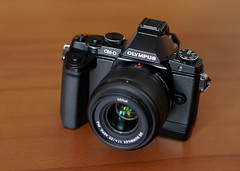Difference between revisions of "Olympus OM-D"
m |
|||
| Line 2: | Line 2: | ||
{{Flickr_image | {{Flickr_image | ||
|image_source= http://www.flickr.com/photos/smallrf/7506049722/in/pool-camerawiki | |image_source= http://www.flickr.com/photos/smallrf/7506049722/in/pool-camerawiki | ||
| − | |image= http://farm9.staticflickr.com/8293/ | + | |image= http://farm9.staticflickr.com/8293/7506049722_d3ae331a61_m.jpg |
|image_align= left | |image_align= left | ||
| − | |image_text= | + | |image_text= <small>Olympus OM-D E-M5 with Summilux 1:1.4/25</small> |
|image_by= fotograf@flickr | |image_by= fotograf@flickr | ||
|image_rights= (c) | |image_rights= (c) | ||
| + | }} | ||
| + | |||
| + | {{Flickr_image | ||
| + | |image_source= https://www.flickr.com/photos/d2gallery/16774094485/in/pool-camerawiki | ||
| + | |image= http://farm8.staticflickr.com/7620/16774094485_7cb354da66_m.jpg | ||
| + | |image_align= right | ||
| + | |image_text= <small>Olympus OM-D E-M10 with fast 17mm lens</small> | ||
| + | |image_by= Bob Delaney | ||
| + | |image_rights= wp | ||
}} | }} | ||
The '''Olympus OM-D''' [[system camera]] bodies resemble the [[35mm]] [[Olympus OM]] SLR series. Again the concept is to surpass the concept of the average concurrent system cameras. Both of the first OM-Ds, the Olympus OM-D EM5 and the newer EM1 reached that goal. Despite of their smaller µ4/3 image sensors both cameras delivered excellent respectable image quality in comparison with average [[APS-C]] sensor format cameras. Backed by this success, maybe [[Olympus]] will give up its [[Four Thirds]] DSLR series since the mirrorless OM-D took over the lead in Olympus camera portfolio. The old Four-Thirds system lenses can be used via adapter on OM-Ds. | The '''Olympus OM-D''' [[system camera]] bodies resemble the [[35mm]] [[Olympus OM]] SLR series. Again the concept is to surpass the concept of the average concurrent system cameras. Both of the first OM-Ds, the Olympus OM-D EM5 and the newer EM1 reached that goal. Despite of their smaller µ4/3 image sensors both cameras delivered excellent respectable image quality in comparison with average [[APS-C]] sensor format cameras. Backed by this success, maybe [[Olympus]] will give up its [[Four Thirds]] DSLR series since the mirrorless OM-D took over the lead in Olympus camera portfolio. The old Four-Thirds system lenses can be used via adapter on OM-Ds. | ||
| + | |||
| + | ===Mark II=== | ||
| + | |||
| + | In 2015 Olympus re-issued the OM-D E-M5, mightily reworked as ''Olympus OM-D E-M5 Mark II''. Its new specialty is a 5-axis sensor-shift anti-shake mechanism. This is also used for an 8-shot High-Res imaging mode with 2.5× sensor resolution as image resolution. | ||
[[Category:Olympus|OM-D]] | [[Category:Olympus|OM-D]] | ||
Revision as of 11:45, 14 March 2015

|
| Olympus OM-D E-M5 with Summilux 1:1.4/25 image by fotograf@flickr (Image rights) |

|
| Olympus OM-D E-M10 with fast 17mm lens image by Bob Delaney (Image rights) |
The Olympus OM-D system camera bodies resemble the 35mm Olympus OM SLR series. Again the concept is to surpass the concept of the average concurrent system cameras. Both of the first OM-Ds, the Olympus OM-D EM5 and the newer EM1 reached that goal. Despite of their smaller µ4/3 image sensors both cameras delivered excellent respectable image quality in comparison with average APS-C sensor format cameras. Backed by this success, maybe Olympus will give up its Four Thirds DSLR series since the mirrorless OM-D took over the lead in Olympus camera portfolio. The old Four-Thirds system lenses can be used via adapter on OM-Ds.
Mark II
In 2015 Olympus re-issued the OM-D E-M5, mightily reworked as Olympus OM-D E-M5 Mark II. Its new specialty is a 5-axis sensor-shift anti-shake mechanism. This is also used for an 8-shot High-Res imaging mode with 2.5× sensor resolution as image resolution.